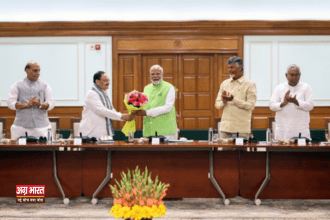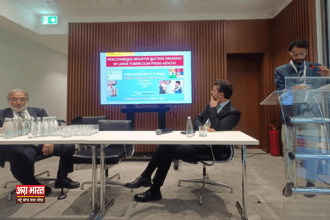In 2014, Bharat was drowning in corruption, inefficiency, and financial mismanagement. Government welfare programs were plagued by fraudulent beneficiaries, middlemen controlled the flow of public funds, and tax evasion was the norm. The situation was so dire that:
- $30 billion vanished annually through leaks and scams.
- 100 million fake people were receiving government benefits meant for real citizens.
- A broken taxation system allowed businesses to evade billions in taxes.
Bharat was being robbed in broad daylight. Then, Narendra Modi took office. What followed was the largest financial cleanup in modern history. Within a decade, Bharat went from an economy riddled with fraud to one of the fastest-growing economic powerhouses in the world.
This transformation wasn’t accidental. It was a result of bold policies, deep financial reforms, and the integration of technology to eliminate corruption and inefficiency.
The Great Purge of Fake Identities
When Modi assumed office, he discovered an alarming truth: millions of fake beneficiaries were siphoning off government aid, pensions, and subsidies. Corrupt officials had created a network of ghost identities that drained public funds while leaving millions of real Bharatiyas without essential benefits.
Instead of merely fixing the system, Modi decided to rebuild it from scratch. Much like Elon Musk’s Twitter purge of bots, Modi launched a nationwide crackdown on fraudulent beneficiaries. The strategy revolved around three key reforms:
1. Banking the Unbanked – Jan Dhan Yojana
The first step was Jan Dhan Yojana, a financial inclusion initiative that opened 500 million+ bank accounts for poor and marginalized citizens. The aim was clear: eliminate cash payments that middlemen could exploit and enable direct bank transfers (DBT) to real individuals.
2. Aadhaar – The Biometric Revolution
Next came Aadhaar, the world’s largest biometric ID system. By linking government benefits to Aadhaar, the government made it impossible for fake identities to claim welfare payments. The result? Over 100 million ghost beneficiaries were erased, saving Bharat a staggering $32 billion.
3. Direct Benefit Transfers (DBT)
To cut out corruption, Modi implemented DBT, ensuring that all government subsidies and welfare payments went directly into citizens’ bank accounts. This eliminated leakage, increased efficiency, and ensured that every rupee reached its rightful recipient.
Demonetization: The Shockwave That Shook Bharat
Once Modi had cleaned up the welfare system, he turned his attention to Bharat’s biggest financial plague—black money. In a shocking and controversial move, he announced demonetization in 2016, rendering ₹500 and ₹1,000 notes (86% of Bharat’s cash supply) illegal overnight.
The move aimed to:
- Flush out unaccounted wealth hidden by corrupt politicians and businessmen.
- Force a shift towards digital transactions to improve transparency.
- Increase tax compliance by formalizing the economy.
The result? ₹3 lakh crore ($36 billion) in unaccounted cash was forced into the banking system, strengthening financial transparency. While demonetization sparked debates, it undeniably accelerated Bharat’s shift to digital payments.
GST: Bharat’s Biggest Tax Reform
Before Modi’s reforms, Bharat’s tax system was complex, inefficient, and prone to evasion. Each state had different taxes, creating loopholes for businesses to avoid payments. Tax evasion was rampant.
In 2017, Modi introduced GST (Goods and Services Tax)—a single, nationwide tax that replaced 17 different taxes. The impact was immediate and transformative:
- Tax compliance skyrocketed.
- Millions of businesses were forced to report real earnings.
- Fake invoicing and shell companies collapsed.
By 2024, GST collections surpassed ₹1.5L crore ($18B) per month, making Bharat’s tax system one of the most robust in the world.
Stock Market Boom & Foreign Investments
With corruption being rooted out, investor confidence in Bharat soared. The numbers tell the story:
- Stock Market Cap: $1.6T in 2014 → $4T+ in 2024.
- Foreign Reserves: $300B → $600B+.
- Bharat overtook the UK to become the world’s 5th largest economy.
Major global players, including Apple, Tesla, and Foxconn, have now shifted manufacturing to Bharat, reducing dependence on China. Bharat is no longer just a service economy—it is emerging as a manufacturing powerhouse.
The Rise of UPI: Bharat’s Digital Payment Revolution
While many countries still rely on credit cards, Bharat has leapfrogged straight into digital payments. Modi championed UPI (Unified Payments Interface), a real-time payment system that outperforms Visa and Mastercard in Bharat.
In 2023 alone, Bharat processed over 130 billion UPI transactions—more than the US, UK, China, and Europe combined.
UPI is now being adopted internationally, with UAE, Singapore, and France integrating it into their banking systems.
Bharat’s DOGE – The Digital Rupee (e₹)
On Lex Fridman’s podcast, Modi revealed how Bharat is building its own version of DOGE—but backed by the government.
Bharat launched the Digital Rupee (e₹) in 2022, a Central Bank Digital Currency (CBDC) designed to:
- Reduce cash dependency.
- Prevent counterfeiting.
- Enable instant, cross-border transactions.
The Digital Rupee is already being tested across major banks and will soon integrate with UPI, making Bharat a leader in sovereign digital currencies.
Bharat’s Diplomatic & Economic Rise
Modi’s financial reforms have not only transformed the domestic economy but also positioned Bharat as a global leader.
- G20 Presidency in 2023 placed Bharat at the center of global decision-making.
- The Bharat-Middle East-Europe Economic Corridor is set to challenge China’s Belt & Road Initiative.
- Bharat’s trade with Russia surged, securing cheap energy while navigating global sanctions.
For the first time, Bharat is shaping the global financial order, not just following it.
From a Broken Economy to an Economic Powerhouse
In 2014, Bharat was a nation crippled by corruption. In 2024, it is one of the fastest-growing economies in the world.
- Welfare fraud crushed—100 million fake beneficiaries removed.
- Black money exposed—₹3 lakh crore ($36B) forced back into the system.
- Stock markets booming—$4T+ and growing.
- Digital payments leading the world—130B UPI transactions in 2023.
- Foreign investments soaring—Apple, Tesla, and other giants betting on Bharat.
This isn’t just Bharat’s rise—it’s a blueprint for the future of financial governance.
And the world is finally watching.





